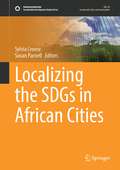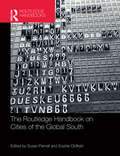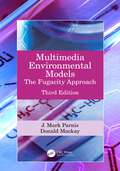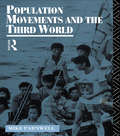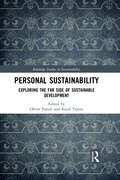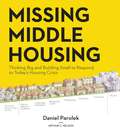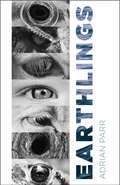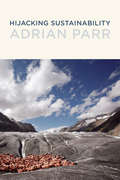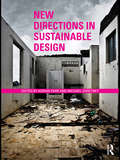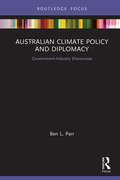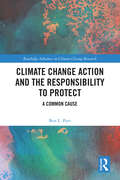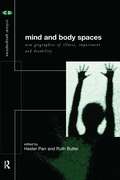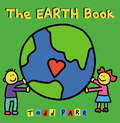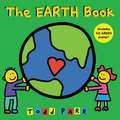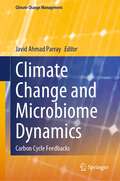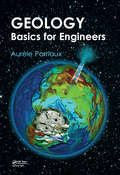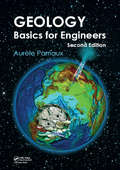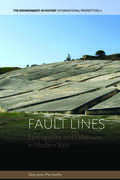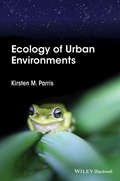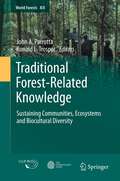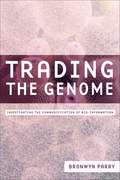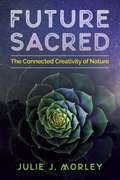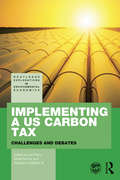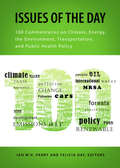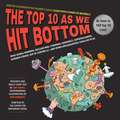- Table View
- List View
Localizing the SDGs in African Cities (Sustainable Development Goals Series)
by Susan Parnell Sylvia CroeseThis volume brings together a unique set of interventions from a variety of contributors to bridge the gap between research and policy with a distinct focus on Africa, drawing on work conducted as part of multiple interconnected research projects and networks on the Sustainable Development Goals (SDGs) and global policy implementation in African cities. Through the framework of the SDGs, and in particular Goal 11, the book aims to contribute to generating new knowledge about approaches to SDG localization that are grounded in complex and diverse local contexts, needs and realities, integrated perspectives and collaborative research. The volume draws together contributions from urban experts from different professional and disciplinary backgrounds, ranging from the fields of governance, planning, data, sustainability, health and finance, to provide critical insight into the current dynamics, actors, blind spots, constraints and also good practices and opportunities for realizing the SDGs in Africa. Readers will gain detailed and informed insight into the African experience of SDG localization, monitoring and implementation based on multiple case studies, and will learn of the practices needed to accelerate action towards achieving the SDGs in urban contexts. This book will be of interest to researchers and planners focusing on SDGs implementation in Africa, as well as government organizations, development practitioners and students committed to long-term, inclusive sustainable and participatory development.
The Routledge Handbook on Cities of the Global South
by Susan Parnell Sophie OldfieldThe renaissance in urban theory draws directly from a fresh focus on the neglected realities of cities beyond the west and embraces the global south as the epicentre of urbanism. This Handbook engages the complex ways in which cities of the global south and the global north are rapidly shifting, the imperative for multiple genealogies of knowledge production, as well as a diversity of empirical entry points to understand contemporary urban dynamics. The Handbook works towards a geographical realignment in urban studies, bringing into conversation a wide array of cities across the global south – the ‘ordinary’, ‘mega’, ‘global’ and ‘peripheral’. With interdisciplinary contributions from a range of leading international experts, it profiles an emergent and geographically diverse body of work. The contributions draw on conflicting and divergent debates to open up discussion on the meaning of the city in, or of, the global south; arguments that are fluid and increasingly contested geographically and conceptually. It reflects on critical urbanism, the macro- and micro-scale forces that shape cities, including ideological, demographic and technological shifts, and constantly changing global and regional economic dynamics. Working with southern reference points, the chapters present themes in urban politics, identity and environment in ways that (re)frame our thinking about cities. The Handbook engages the twenty-first-century city through a ‘southern urban’ lens to stimulate scholarly, professional and activist engagements with the city.
Multimedia Environmental Models: The Fugacity Approach
by J. Mark Parnis Donald MackayMultimedia Environmental Models: The Fugacity Approach, Third Edition, takes a broad approach of viewing chemical behavior in the total biosphere of connected biotic and abiotic compartments. Chemicals are subject to the laws of "mass balance," a constraint that provides the opportunity to establish quantitative expressions for chemical fate that are central to chemical management and regulatory legislation. This book employs both the conventional concentration-based procedures and those based on application of the more elegant and powerful concept of fugacity to characterize equilibrium, steady-state distribution, and time-dependent transport between environmental phases such as air, water, and soil. Organic chemicals are emphasized because they are more easily generalized when assessing environmental behavior.Features Illustrates professional approaches to calculating the fate of chemicals in the environment Explicitly details all worked examples in an annotated step-by-step fashion Presents real-life freely downloadable models of use to government, industry, and private consulting professionals and students alike Clarifies symbols and notation
Population Movements and the Third World (Routledge Introductions to Development)
by Mike ParnwellThe interrelationship between migration and development is complex. The causes of migration stem from the uneveness of the development process and the effects exert a powerful influence on the pattern and process of development. This volume explores both the concepts and facts behind the main forms of population movement in the third world today, particularly rural-urban migration. Examining the causes and consequences of migration, the author assesses the implications for planning and policy-makers.
Personal Sustainability: Exploring the Far Side of Sustainable Development (Routledge Studies in Sustainability)
by Oliver Parodi Kaidi TammTransition to sustainability is stuck and academic research has not resulted in significant change so far. A large void in sustainability research and the understanding of sustainable development is an important reason for this. Personal Sustainability seeks to address this void, opening up a whole cosmos of sustainable development that has so far been largely unexplored. Mainstream academic, economic and political sustainable development concepts and efforts draw on the macro level and tend to address external, collective and global processes. By contrast, the human, individual, intra- and inter-personal aspects on the micro level are often left unaddressed. The authors of Personal Sustainability invite the reader on a self-reflecting journey into this unexplored inner cosmos of sustainable development, focusing on subjective, mental, emotional, bodily, spiritual and cultural aspects. Although these are intrinsically human aspects they have been systematically ignored by academia. To establish this new field in sustainability research means to leave the common scientific paths and expand the horizon. Together with authors from cultural studies, philosophy, anthropology, psychology, sociology, psychiatry, aesthetics and economics, and supported by contributions from practitioners, this book portrays different approaches to personal sustainability and reflects on their potentials and pitfalls, paving the way to cultures of sustainability. This book will be of great interest to researchers and students in the field of sustainability and sustainable development, as well as researchers from philosophy, anthropology, psychology, sociology, cultural studies, ethnology, educational research, didactics, aesthetics, economics, business and public administration.
Missing Middle Housing: Thinking Big and Building Small to Respond to Today's Housing Crisis
by Daniel G. ParolekToday, there is a tremendous mismatch between the available housing stock in the US and the housing options that people want and need. The post-WWII, auto-centric, single-family-development model no longer meets the needs of residents. Urban areas in the US are experiencing dramatically shifting household and cultural demographics and a growing demand for walkable urban living. Missing Middle Housing, a term coined by Daniel Parolek, describes the walkable, desirable, yet attainable housing that many people across the country are struggling to find. Missing Middle Housing types—such as duplexes, fourplexes, and bungalow courts—can provide options along a spectrum of affordability. In Missing Middle Housing, Parolek, an architect and urban designer, illustrates the power of these housing types to meet today's diverse housing needs. With the benefit of beautiful full-color graphics, Parolek goes into depth about the benefits and qualities of Missing Middle Housing. The book demonstrates why more developers should be building Missing Middle Housing and defines the barriers cities need to remove to enable it to be built. Case studies of built projects show what is possible, from the Prairie Queen Neighborhood in Omaha, Nebraska to the Sonoma Wildfire Cottages, in California. A chapter from urban scholar Arthur C. Nelson uses data analysis to highlight the urgency to deliver Missing Middle Housing. Parolek proves that density is too blunt of an instrument to effectively regulate for twenty-first-century housing needs. Complete industries and systems will have to be rethought to help deliver the broad range of Missing Middle Housing needed to meet the demand, as this book shows. Whether you are a planner, architect, builder, or city leader, Missing Middle Housing will help you think differently about how to address housing needs for today's communities.
Earthlings: Imaginative Encounters with the Natural World
by Adrian ParrAmid environmental catastrophe, it is vital to recall what unites all forms of life. We share characteristics and genetic material extending back billions of years. More than that, we all—from humans to plants to bacteria—share a planet. We are all Earthlings.Adrian Parr calls on us to understand ourselves as existing with and among the many forms of Earthling life. She argues that human survival requires us to recognize our interdependent relationships with the other species and systems that make up life on Earth. In a series of meditations, Earthlings portrays the wonder and beauty of life with deep feeling, vivid detail, and an activist spirit. Parr invites readers to travel among the trees of the Amazonian rainforest; take flight with birds and butterflies migrating through the skies; and plunge into the oceans with whales and polar bears—as well as to encounter bodies infected with deadly viruses and maimed by the violence of global capitalism.Combining poetic observation with philosophical contemplation and scientific evidence, Parr offers a moving vision of a world in upheaval and a potent manifesto for survival. Earthlings is both a joyful celebration of the magnificence of the biosphere and an urgent call for action to save it.
Hijacking Sustainability
by Adrian ParrHow the sustainability movement has been co-opted: from ecobranding by Wal-Mart to the “greening” of the American military.The idea of “sustainability” has gone mainstream. Thanks to Prius-driving movie stars, it's even hip. What began as a grassroots movement to promote responsible development has become a bullet point in corporate ecobranding strategies. In Hijacking Sustainability, Adrian Parr describes how this has happened: how the goals of an environmental movement came to be mediated by corporate interests, government, and the military. Parr argues that the more popular sustainable development becomes, the more commodified it becomes; the more mainstream culture embraces the sustainability movement's concern over global warming and poverty, the more “sustainability culture” advances the profit-maximizing values of corporate capitalism. And the more issues of sustainability are aligned with those of national security, the more military values are conflated with the goals of sustainable development.Parr looks closely at five examples of the hijacking of sustainability: corporate image-greening; Hollywood activism; gated communities; the greening of the White House; and the incongruous efforts to achieve a “sustainable” army. Parr then examines key challenges to sustainability—waste disposal, disaster relief and environmental refugees, slum development, and poverty.Sustainability, Parr says, offers an alternative narrative of the collective good—an idea now compromised and endangered by corporate, military, and government interests.
New Directions in Sustainable Design
by Adrian Parr Michael ZaretskyRecently there has been a plethora of work published on the topic of sustainability, much of which is purely theoretical or technical in its approach. More often than not these books fail to introduce readers to the larger challenge of what thinking sustainably might entail. Combining a series of well know authors in contemporary philosophy with established practitioners of sustainable design, this book develops a coherent theoretical framework for how theories of sustainability might engage with the growing practice of design. This book: brings together new and emerging perspectives on sustainability provides cohesive and jargon-free reading articulates the specificity of both theory and practice, to develop a symbiotic relationship which allows the reader to understand what thinking sustainably entails This volume describes a variety of new ways to approach sustainable design and it equips the next generation of designers with necessary conceptual tools for thinking sustainably.
Australian Climate Policy and Diplomacy: Government-Industry Discourses (Routledge Focus on Environment and Sustainability)
by Ben L. ParrAustralian Climate Policy and Diplomacy provides a well overdue critique of existing, and high-profile, publications that convey the ‘greenhouse mafia’ hypothesis, which posits that Australia’s weak policy response to climate change is the result of a menacing domestic fossil fuel lobby. Ben L. Parr argues that the shared government–industry discourse about protecting Australia’s industrial competitiveness has had a more decisive influence in shaping and legitimising Australian climate policy than the direct lobbying tactics of the fossil fuel industry. Parr also reveals how the divergent foreign policy discourses and traditions of Australia’s two major political parties – as internationalist versus alliance-focused – have enabled and constrained their climate diplomacy and domestic policies over time. To demonstrate his argument, he presents a discourse analysis woven into a chronological policy narrative, comprising more than 1000 primary texts (media releases, interviews, and speeches) generated by prime ministers and key fossil fuel lobbyists. Overall, this volume illustrates how domestic forces have and are influencing Australia’s climate policy. In doing so, it also provides a framework that can be adapted to examine climate mitigation policies in other countries, notably Canada and the US. This book will be of interest to students and scholars of climate change, environmental policy and governance, and Australian climate change policy and politics more specifically, as well as policymakers and practitioners working in these fields.
Climate Change Action and the Responsibility to Protect: A Common Cause (Routledge Advances in Climate Change Research)
by Ben L. ParrThis book brings together two important fields in the study of international politics and policy: climate change adaptation and mitigation (climate action) and the Responsibility to Protect (R2P). Both have attracted strong scholarly attention in each of their respective research silos, but there is yet to be a strong research push that explores the relationship between the two. Filling this gap, Ben L. Parr argues that the climate action and the R2P agendas share a common goal: to protect vulnerable human populations from large-scale harm. To substantiate this argument, Parr reveals where the historical, conceptual, and operational parallels exist between the two agendas, and where and when researchers and practitioners from both camps might work together in practice to achieve their common goal in the challenging years ahead. Notably, the book builds on recent efforts by Western governments in the UK, US, and EU to integrate climate action policies into conflict prevention and response policies. To achieve this, the volume situates a variety of climate action policies alongside the 46 policy options found in the R2P operational framework (commonly known as the R2P toolbox) across its prevention, reaction, and rebuilding phases. Climate Change Action and the Responsibility to Protect will be of significant interest to policy-orientated students and scholars, those working at the academic-policy interface in the NGO community, as well as those working in government and international organisations.
Mind and Body Spaces: Geographies of Illness, Impairment and Disability (Critical Geographies #Vol. 1)
by Hester Parr Ruth ButlerMind and Body Spaces highlights new international research from Britain, USA, Canada and Australia, on bodily impairment, mental health and disabled peoples social worlds. The contributors discuss a variety of current issues including:* historical conceptions of the body and behaviour* contemporary political activism* matters of identity and employment* accessible housing* parenthood and child carers* psychiatric medication use* masculinity and sexuality* autobiography* social exclusion and inclusion. The contributors are: Hester Parr, Ruth Butler, Rob Imrie, Michael L. Dorn, Deborah Carter Park, John Radford, Brendan Gleeson, Isabel Dyck, Edward Hall, Pamela Moss, Gill Valentine, Christine Milligan, Flora Gathorne-Hardy, Jane Stables, Fiona Smith and Vera Chouinard.
The EARTH Book
by Todd Parr"I take care of the earth because I know I can do little things every day to make a BIG difference. . . " With his signature blend of playfulness and sensitivity, Todd Parr explores the important, timely subject of environmental protection and conservation in this eco-friendly picture book. Featuring a circular die-cut Earth on the cover, and printed entirely with recycled materials and nontoxic soy inks, this book includes lots of easy, smart ideas on how we can all work together to make the Earth feel good - from planting a tree and using both sides of the paper, to saving energy and reusing old things in new ways. Best of all, the book includes an interior gatefold with a poster with tips/reminders on how kids can "go green" everyday. Equally whimsical and heartfelt, this sweet homage to our beautiful planet is sure to inspire readers of all ages to do their part in keeping the Earth happy and healthy.
The EARTH Book (Melded Audio and Text)
by Todd Parr"I take care of the earth because I know I can do little things every day to make a BIG difference..."With his signature blend of playfulness and sensitiviy, Todd Parr explores the important, timely subject of environmental protection and conservation in this eco-friendly picture book. Featuing a circular die-cut Earth on the cover, and printed entirely with recycled materials and nontoxic soy inks, this book includes lots of easy, smart ideas on how we can all work together to make the Earth feel good - from planting a tree and using both sides of the paper, to saving energy and reusing old things in new ways.Best of all, the book includes an interior gatefold with a poster with tips/reminders on how kids can "go green" everyday. Equally whimsical and heartfelt, this sweet homage to our beautiful planet is sure to inspire readers of all ages to do their part in keeping the Earth happy and healthy.
Climate Change and Microbiome Dynamics: Carbon Cycle Feedbacks (Climate Change Management)
by Javid Ahmad ParrayThe book provides an overview relevant to various biological mechanisms that regulate carbon exchanges between the major components and their response to climate change. Climate change has a significant impact on people's lives, energy demand, food security, etc. The soil microbial ecology is vital for assessing terrestrial and aquatic carbon cycles and climate feedback. However, the primary concern is the complexity of the soil microbial community and its severely affected functions due to the climate and other global changes. Global warming comprises an assessment of the dynamic interactions and feedback between microbes, plants, and their physical environment due to climate change. The book will address the need to use a multifactor experimental approach to understand how soil microorganisms and their activities adapt to climate change and the implications of carbon cycle feedback. The most pressing concern is a clearer understanding of the biological factors that regulate carbon exchanges between land, oceans, and the atmosphere and how these exchanges will respond to climate change via climate–ecosystem feedbacks, which could augment or quell regional and global climate change. Terrestrial ecosystems play an important role in climate feedback as they produce and absorb greenhouse gases like carbon dioxide, methane, and nitrous oxides. They also strongly contribute to storing enormous amounts of carbon in living vegetation and soils, rendering them a significant global carbon sink. If climate change projections are realistic, such a rapid increase in carbon loss from soil could exacerbate the soil carbon cycle feedback. The book will determine the role of microbial feedback in regulating soil-land-atmosphere carbon exchange under changing climatic conditions at the regional and global levels. The current book will also focus on recent research designed to use beneficial microbes such as plant growth-promoting microorganisms, fungi, endophytic microbes, and others to improve understanding of the interaction and their potential role in promoting advanced management for sustainable agricultural solutions. Understanding the influence on the native microbiome, such as the distribution of methanogens and methanotrophs, nutritional content, microbial biomass, and other factors, is becoming increasingly crucial to establishing climate-resilient agriculture.
Geology: Basics for Engineers
by Aurele ParriauxGeology – Basics for Engineers presents the physical and chemical characteristics of the Earth, the nature and the properties of rocks and unconsolidated deposits/sediments, the action of water, how the earth is transformed by various phenomena at different scales of time and space. The book shows the engineer how to take geological conditions into account in his projects, and how to exploit a wide range of natural resources in an intelligent way, reduce geological hazards, and manage subsurface pollution.Through a problem-based-learning approach, this instructional text imparts knowledge and practical experience to engineering students (undergraduate and graduate level), as well as to experts in the fields of civil engineering, environmental engineering, earth sciences, architecture, land and urban planning. The DVD that supplements the book contains solutions to the problems and animations that show additional facets of the living Earth. *The original French edition of the book (2007) won the prestigious Roberval Prize, an international contest organized by the University of Technology of Compiegne in collaboration with the General Council of Oise, France. Geology, Basics for Engineers, was selected out of a total of 110 candidates.The jury praised the book as a “very well conceived teaching textbook” and underscored its highly didactic nature, as well as the excellent quality of its illustrations.
Geology: Basics for Engineers, Second Edition
by Aurèle ParriauxGeology – Basics for Engineers (second edition) presents the physical and chemical characteristics of the Earth, the nature and the properties of rocks and unconsolidated deposits/sediments, the action of water, how the Earth is transformed by various phenomena at different scales of time and space. The book shows the engineer how to take geological conditions into account in their projects, and how to exploit a wide range of natural resources in an intelligent way, reduce geological hazards, and manage subsurface pollution. This second edition has been fully revised and updated. Through a problem-based learning approach, this instructional text imparts knowledge and practical experience to engineering students (undergraduate and graduate level), as well as to experts in the fields of civil engineering, environmental engineering, earth sciences, architecture, land and urban planning. Free digital supplements to the book, found on the book page, contain solutions to the problems and animations that show additional facets of the living Earth. The original French edition of the book (2007) won the prestigious Roberval Prize, an international contest organized by the University of Technology of Compiegne in collaboration with the General Council of Oise, France. Geology, Basics for Engineers was selected out of a total of 110 candidates. The jury praised the book as a "very well conceived teaching textbook" and underscored its highly didactic nature, as well as the excellent quality of its illustrations.
Fault Lines: Earthquakes and Urbanism in Modern Italy (Environment in History: International Perspectives #6)
by Giacomo ParrinelloEarth’s fractured geology is visible in its fault lines. It is along these lines that earthquakes occur, sometimes with disastrous effects. These disturbances can significantly influence urban development, as seen in the aftermath of two earthquakes in Messina, Italy, in 1908 and in the Belice Valley, Sicily, in 1968. Following the history of these places before and after their destruction, this book explores plans and developments that preceded the disasters and the urbanism that emerged from the ruins. These stories explore fault lines between “rural” and “urban,” “backwardness” and “development,” and “before” and “after,” shedding light on the role of environmental forces in the history of human habitats.
Ecology of Urban Environments
by J. ParrisStudies the distribution, abundance and behaviour of organisms, their interactions with each other and with their urban environment Case studies with questions to improve retention and understanding Uses existing ecological theory to identify generalities and complexities in the urban ecosystems Discusses the urban ecology of humans, community-level, ecosystem-level, and population-and species-level responses to urbanization
Traditional Forest-Related Knowledge
by John A. Parrotta Ronald L. TrosperExploring a topic of vital and ongoing importance, Traditional Forest Knowledge examines the history, current status and trends in the development and application of traditional forest knowledge by local and indigenous communities worldwide. It considers the interplay between traditional beliefs and practices and formal forest science and interrogates the often uneasy relationship between these different knowledge systems. The contents also highlight efforts to conserve and promote traditional forest management practices that balance the environmental, economic and social objectives of forest management. It places these efforts in the context of recent trends towards the devolution of forest management authority in many parts of the world. The book includes regional chapters covering North America, South America, Africa, Europe, Asia and the Australia-Pacific region. As well as relating the general factors mentioned above to these specific areas, these chapters cover issues of special regional significance, such as the importance of traditional knowledge and practices for food security, economic development and cultural identity. Other chapters examine topics ranging from key policy issues to the significant programs of regional and international organisations, and from research ethics and best practices for scientific study of traditional knowledge to the adaptation of traditional forest knowledge to climate change and globalisation.
Trading the Genome: Investigating the Commodification of Bio-Information
by Bronwyn ParryIn a groundbreaking work that draws on anthropology, history, philosophy, business and law, Parry links firsthand knowledge of the operation of the bioprospecting industry to a sophisticated analysis of broader economic, regulatory, and technological transformations to reveal the complex economic and political dynamics that underpin the new global trade in bio-information.
Future Sacred: The Connected Creativity of Nature
by Glenn Aparicio Parry Julie J. MorleyReveals how our survival depends on embracing complexity consciousness and relating to nature and all life as sacred • Rejects the “survival of the fittest” narrative in favor of sacred symbiosis, creative cooperation, interdependence and complex thinking • Provides examples from complexity studies, cultural history, philosophy, indigenous spirituality, biomimicry, and ecology to show how nature’s intelligence and creativity abound everywhere • Documents how indigenous cultures lived in relative harmony with nature because they perceived themselves as part of the “ordered whole” of all life In Future Sacred, Julie J. Morley offers a new perspective on the human connection to the cosmos by unveiling the connected creativity and sacred intelligence of nature. She rejects the “survival of the fittest” narrative--the idea that survival requires strife--and offers symbiosis and cooperation as nature’s path forward. She shows how an increasingly complex world demands increasingly complex consciousness. Our survival depends upon embracing “complexity consciousness,” understanding ourselves as part of nature, as well as relating to nature as sacred. Morley begins by documenting how indigenous cultures lived in relative harmony with nature because they perceived themselves as part of the “ordered whole” of all life--until modernity introduced dualistic thinking, thus separating mind from matter, and humans from nature. The author deconstructs the fallacy behind social and neo-Darwinism and the materialist theories of “dead matter” versus those that offer a connection with the sentient mind of nature. She presents evidence from complexity studies, cultural history, philosophy, indigenous spirituality, biomimicry, and ecology, highlighting the idea that nature’s intelligence and creativity abound everywhere--from cells to cetaceans, from hydrogen to humans, from sunflowers to solar panels--and that all sentient beings contribute to the evolution of life as a whole, working together in sacred symbiosis. Morley concludes that our sacred future depends on compassionately understanding and integrating multiple intelligences, seeing relationships and interdependence as fundamental and sacred, as well as honoring the experiences of all sentient beings. Instead of “mastery over nature,” we must shift toward synergy with nature--and with each other as diverse expressions of nature’s creativity.
Implementing a US Carbon Tax: Challenges and Debates (Routledge Explorations in Environmental Economics)
by Ian Parry Adele Morris Roberton C. Williams IIIAlthough the future extent and effects of global climate change remain uncertain, the expected damages are not zero, and risks of serious environmental and macroeconomic consequences rise with increasing atmospheric greenhouse gas concentrations. Despite the uncertainties, reducing emissions now makes sense, and a carbon tax is the simplest, most effective, and least costly way to do this. At the same time, a carbon tax would provide substantial new revenues which may be badly needed, given historically high debt-to-GDP levels, pressures on social security and medical budgets, and calls to reform taxes on personal and corporate income. This book is about the practicalities of introducing a carbon tax, set against the broader fiscal context. It consists of thirteen chapters, written by leading experts, covering the full range of issues policymakers would need to understand, such as the revenue potential of a carbon tax, how the tax can be administered, the advantages of carbon taxes over other mitigation instruments and the environmental and macroeconomic impacts of the tax. A carbon tax can work in the United States. This volume shows how, by laying out sound design principles, opportunities for broader policy reforms, and feasible solutions to specific implementation challenges.
Issues of the Day: 100 Commentaries on Climate, Energy, the Environment, Transportation, and Public Health Policy (RFF Report)
by Ian W.H. Parry Felicia DayIssues of the Day provides an easy way for students, academics, journalists, policymakers, and the public to learn about a diverse range of policy issues affecting the environment, energy, transportation, and public health. Each commentary gives a short assessment of a topic, summarizing in a non-technical way the current state of analysis or evidence on the issue, along with selected recommendations for further reading. The essays are written by world renowned scholars, mostly economists, and provide useful insights on policy problems that are often complex and poorly understood. Some of the topics covered include air pollution, hazardous waste, voluntary environmental programs, domestic (U.S.) and global climate policy design, fishery management, water quality, endangered species, forest fires, oil security, solar power, road and airport, fuel taxes and fuel economy standards, alternative fuel vehicles, health and longevity, smoking, malaria, tuberculosis, and the environment and development. The objective is to disseminate the findings of sound, objective research on the costs, benefits, and appropriate reform of public policies. The book provides a useful supplement for undergraduate- and graduate-level course reading, a reference guide for professionals, and a way for the general reader to quickly develop an informed perspective on the most important policy problems of the day. Issues of the Day is available to download as a PDF from the Resources for the Future website: www.rff.org/weeklycommentary
The Top 10 As We Hit Bottom: What Global Warming, Nuclear War, Cyberwar, Pandemics, Supervolcanoes, Asteroid Strikes, Out-of-Control A.I., and Other Unpleasantries Could Do to Us.
by Jim ParryFrom best-selling author and illustrator Ron Barrett, who forecasted the weather in the classic picture book, Cloudy With a Chance of Meatballs, now predicts how—thanks to climate change and other unpleasantries—the world will end! With research and really scary text by Jim Parry, The Top Ten As We Hit Bottom is a darkly humorous collection of &“Top Ten&” lists that highlights the predicament global warming and other impending catastrophes have put us into. Though some might call these lists &“fake news&” (we&’re looking at you, Donald), these lists are compiled and culled from the world's most credible authorities like NASA, the UN, and the Union of Concerned Scientists. But coupled with darkly humorous illustrations, you&’ll be laughing your way all the way down in our race toward the bottom! Here are some Top 10 lists to whet your appetite for Earth&’s impending doom: &“Top 10 species we&’ll lose to climate change&”&“Top 10 avalanches mostly caused by global warming&”&“Top 10 climate change deniers&”&“Top 10 times we almost had a nuclear war,&”&“Top 10 things that will happen when the Yellowstone Supervolcano erupts,&”&“Top 10 ways to try to stop an asteroid,&”&“Top 10 signs that the earth is about to be swallowed by a black hole,&”&“Top 10 ways a particle accelerator mishap could destroy the world,&”&“Top 10 end-of-world cults you can join now.&”And many more!
